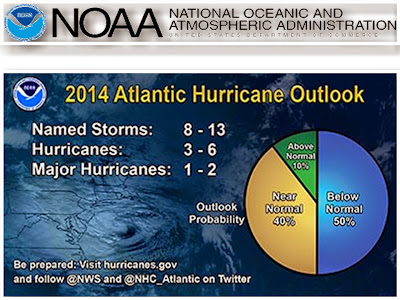“Thanks
to the environmental intelligence from NOAA’s network of earth observations,
our scientists and meteorologists can provide life-saving products like our new
storm surge threat map and our hurricane forecasts”
NOAA (National Oceanic
and Atmospheric Administration) Administrator Dr. Kathryn Sullivan commenting
on the 2014 Atlantic Hurricane Season
Looks
like we’re in for a wild ride, Jamaican and Caribbean people! And here was I
thinking that the spreading Chikungunya Virus Epidemic in the Caribbean was bad
enough, as it’s yet to be reported in Jamaica as I’d predicted in my blog article entitled
“Ministry
of Health gearing up for Chikungunya Virus Epidemic - Aedes aegypti Mosquito
loves the French as it Island-Hops to Jamaica”.
 |
It’s
looking a lot calmer than last year’s Hurricane Season, which Neville Bell of
Television Jamaica Fame had spoken of, naming Hurricane Barbara to start things
off rolling as stated in my blog article entitled
“Neville
Bell Hurricane Barbara the first for Atlantic and Pacific Hurricane Season
starting Saturday June 1 2012 - Caribbean theatre for the Class of Hurricanes
in Monsters University”.
The
names to be used for this
year’s 2014 Hurricane Season are as follows and are actually based on names
handed down by the National Hurricane Center:
1.
Arthur
2.
Bertha
3.
Cristobal
4.
Dolly
5.
Edouard
6.
Fay
7.
Gonzalo
8.
Hanna
9.
Isaias
10.
Josephine
11.
Kyle
12.
Laura
13.
Marco
14.
Nana
15.
Omar
16.
Paulette
17.
Rene
18.
Sally
19.
Teddy
20.
Vicky
21.
Wilfred
According
to NOAA (National Oceanic and Atmospheric Administration) Administrator Dr.
Kathryn Sullivan, this years is below or just average in terms of Hurricanes
expected to form in the Atlantic Hurricane Region. Those odds, for the bookies
reading my blog and getting ready to place their bets, read as thus:
1.
50% chance of a below-normal season
2.
40% chance of a near-normal season
3.
10% chance of an above-normal season
4.
70% likelihood of Hurricanes in the
Caribbean this year
This
Region is defined as:
1.
North Atlantic Ocean
2.
Caribbean Sea
3.
Gulf of Mexico
In
terms of the number of Hurricanes, this translates as thus:
1.
8-13 named Storms
2.
3-6 hurricanes
3.
1-2 Category 3, 4 or 5 hurricanes (winds
of 111 mph or higher)
For
those that are non-weather oriented, these Atmospheric anomalies translate as
follows:
1.
Storms have winds of 39 mph or higher
2.
Hurricanes have winds of 74 mph or
higher
3.
Category 3, 4 or 5 hurricanes start at
wind speeds of winds of 111 mph or higher
The
video below best illustrates how a Hurricane is formed very clearly, since as
far as I'm concerned as a Jamaican, given the state of our Infrastructure, they
ALL mean I have to batten down and prepare for Islandwide power Cuts.
El Nino is on our Side
– Takes only one Hurricane making Landfall to cause a Disaster
The
reason for the below-par Hurricane Season?
Blame
the El Nino effect, which is apparently on our side. This as it makes
Hurricanes more difficult to form via the following actions
1.
Strong Shear Winds that tear Storm Cell
formation apart, making hurricane formation off the coast of Africa difficult
2.
Strengthen the Trade Winds coming off
Africa
3.
Reduce the warm water effect off the
coast of Africa
 |
True
indeed! Right now I’m in Kingston. I’ve already begun tracking the Hurricane
formation and making plans to go home to Milk River, Clarendon instead of risk
being Trapped in Kingston. Folks, be prepared!
No comments:
Post a Comment